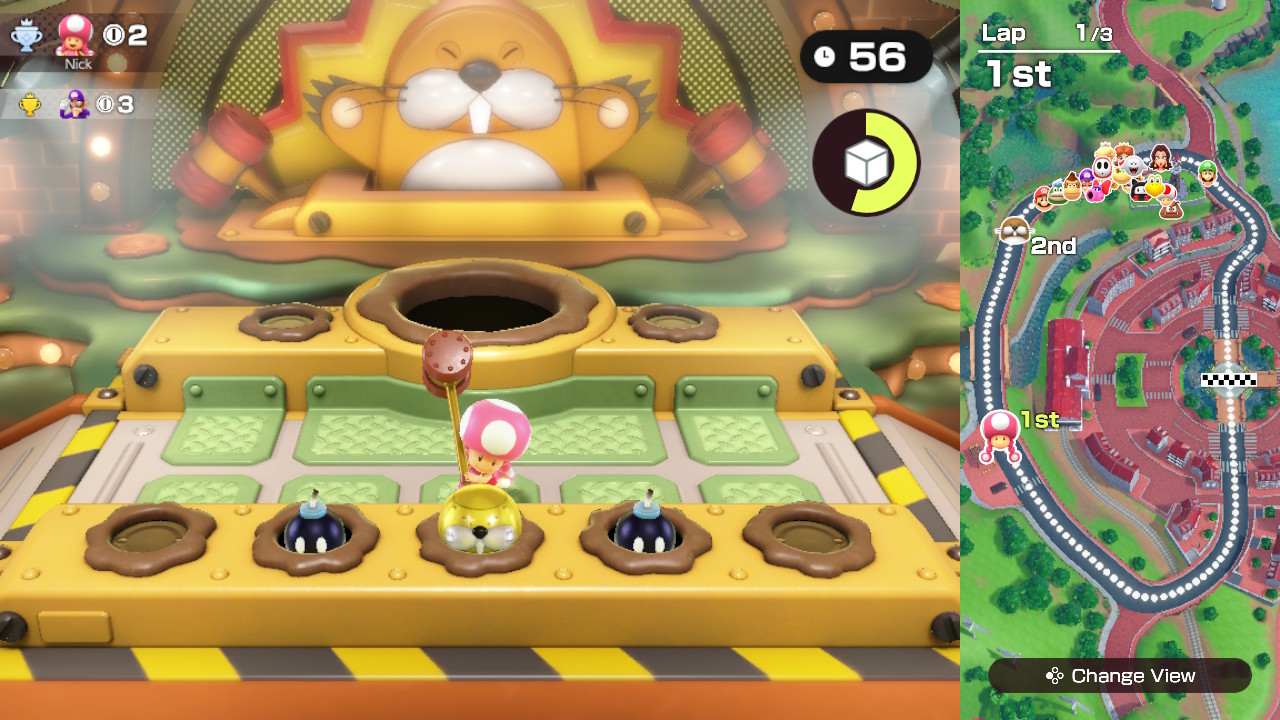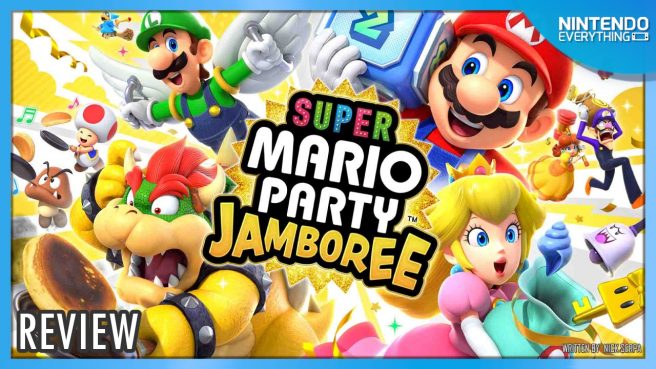Super Mario Party Jamboree review
System: Switch
Release date: October 17, 2024
Developer: NDcube
Publisher: Nintendo
Like clockwork, roughly about every three years, Nintendo releases a new Mario Party game. That may seem like a lot, but it’s easy to forget that that for most of the series’ life these titles were getting cranked out on an annual basis. Nowadays though, Nintendo is spending more time and resources on these games than ever before – and it shows. While 2021’s Mario Party Superstars felt like a refreshing trip down memory lane, Super Mario Party Jamboree raises the bar for the series on multiple levels, from its clever and dynamic game boards to its robust suite of online options and modes. My nostalgia for the older entries aside, this one represents easily some of the most fun I’ve ever had in a Mario Party game, and it’s secured a spot as my new go-to title for multiplayer madness on the. Switch Lite players will want to pause before picking this game up – but everyone else has a lot to look forward to.
You could certainly make an argument that at this point in the Switch’s life, Nintendo probably didn’t need to release another Mario Party game, but Super Mario Party Jamboree very quickly made a strong case for its existence when I realized just how jam-packed with creative and entertaining ideas this game is. It has no less than eight modes, and while some of these experiences are more replayable than others, together they form a generous package that truly feels like it has something for everyone. Yes, of course, there’s your standard Mario Party board game experience – with the expected twists sprinkled about to shake things up, of course – but there’s also a rhythm mode, a cooperative tower-defense style mode, a 5-6 hour dedicated single-player adventure mode, and more beyond that. Even if you were to play through everything this game has to offer exactly once, you’re probably still facing at least 15-20 hours of content – and of course, when you take into account that the core appeal of this series for most is goofing around with friends in front of the TV, that number balloons exponentially.

Speaking of balloons, a hot air balloon acts as the sort of main menu for the various modes of Super Mario Party Jamboree. After I picked my character and launched up into the sky, it quickly became clear that Nintendo spared no expense in making this the best looking Mario Party game to date. Visually, it’s such a feast for the senses that it can almost be overwhelming at times, so dense with vibrant colors and bouncy animations that the dopamine sensors in my monkey brain were firing on all cylinders almost constantly. The animations are top-notch, and make even losing entertaining, as seeing the various “defeat” poses of the characters after a rocky round of minigames never failed to make me smile. The game is simply bursting with energy and charisma, and playing it feels like visiting a living, breathing Mario theme park, except without all the crowds and long lines.
Of course, what’s most important in a Mario Party game is the eponymous main mode itself, which has four players sprinting around a board game-style map to collect the most stars – be that by earning coins and participating in capitalism, or by sweeping the rug out from under opponents during the final round. Super Mario Party Jamboree generally respects the fundamentals of this series – you roll your dice block, move around the board (separately from other players, thank God), land on a good space or a bad space, play a minigame, and proceed. If you’ve played a Mario Party game before, you’ll have no issue jumping into Jamboree – and if you’re new, the game does an excellent job explaining the basic rules, what the various spaces do, and the unique features of each board.

The titular new Jamboree mechanic is the single biggest gameplay shakeup to the moment-to-moment Mario Party experience, and while it’s not something that will define every round of a match, it really can turn the tides of a game quite quickly. The way it works is that at random intervals over the course of a match, non-player partner characters will appear on the board. If a player can reach them in three turns, and also win a special minigame, that partner character will ally up with the player and follow them around the board, giving them all kinds of special bonuses. Some of these bonuses are unique to each character – for example, teaming up with Donkey Kong will allow the player to blast off to a random place on the board before their next turn, while having Luigi around makes it more likely that the player will be able to roll high numbers. Additionally, having a Jamboree Buddy by your side makes it possible to do many things twice, from doubling the amount of coins you receive when you land on a blue space, to making it possible to buy two Stars or Items in a single turn. But caution is required, because negative effects are also amplified twice – which can really screw you over if you’re unlucky or reckless.
I really loved this mechanic and hope it returns in future games, because it feels like such a natural extension of what makes Mario Party such a blast. It takes both a little bit of skill and a little bit of luck to make the most of Jamboree Buddies, and a really strong turn with them on your side can shift the balance of the entire game. Of course, when you’re on the other side of that dynamic it can be frustrating to see your lead crumble away, but it’s the kind of “fun” frustration that comes with a healthy competition. This gameplay rhythm has been honed to perfection in Super Mario Party Jamboree, ensuring that underdog victories will be frequent – at least with the default rules enabled. An optional setting called Pro Rules is available, which minimizes some of the luck-based elements under the default ruleset for a moderately more strategic experience. For example, under these rules, items at shops don’t replenish once sold out, the criteria for Bonus Star awards is outlined at the start of the game, and certain luck-boosting spaces have been changed to something else. This can be a really satisfying way to compete against other players for those with a more competitive mindset, and I enjoyed switching between the two playstyles depending on my mood and current patience levels.
Super Mario Party Jamboree contains seven game boards, more than many entries in the series – and I’m pleased to report that they’re all great fun, although some of them are stronger than others. Among the five new boards, my favorite is Rainbow Galleria, which is a multi-floor shopping mall that is dense with branching paths. Players will need to take the escalators between the various floors, and oftentimes the challenge on this board comes from making sure you are taking the most efficient path to your goal. The theming on this map is impeccable as well – I loved that I could use a “Markup Sticker” to make an opponent’s purchases more expensive, and that I could gain extra coins by filling out a promotional stamp card, like the little loyalty cards that some real-world shops will distribute. The two returning boards are great fun as well – Western Land is set along a train track in a cowboy-themed town, and there are few Mario Party experiences more satisfying than summoning the train and launching your foes across the board. Really, the only board in the game I didn’t totally click with was Roll’em Raceway. While the idea of racing around the board a-la Mario Kart is clever on paper, the layout on this one has fewer opportunities to diverge onto a different path, and so the primary focus is on completing laps around the board. In other words, if you’re not rolling high numbers – which is largely out of the player’s hands – you’ll have a hard time catching up on this one.

If you like playing a round of Mario Party online, you’ll be excited to hear that internet play in Super Mario Party Jamboree is consistently stable and reliable at the same level of high quality that was found in Mario Party Superstars. Crucially, considering how long these games can be (over 90 minutes, easily), if a player quits mid-game they’ll be replaced by a CPU, meaning matches won’t be interrupted by rage-quitters or busy adults. I also didn’t notice any discernible latency during my playthrough even in the minigames, which is where it would typically be most noticeable.
Speaking of minigames, Super Mario Party Jamboree has a strong selection of them, although there are a few caveats to consider. The biggest one is that while Nintendo will advertise this game as having roughly 110 minigames, only some of those are available within the main board game mode itself, and the rest are spread across the other game modes. That number is reduced further if you are playing on a Switch Lite, as any motion-based minigames require detached Joy-Cons to play – as do several of Jamboree’s side modes. Overall, though, the minigames that are available for board game play are all of excellent quality. They’re generally all mechanically simple enough so that anyone can pick up and play them, but that doesn’t make them any less fun – and it’s always possible to crank up the difficulty when playing with CPU opponents if you want more of a challenge, which I appreciated.
Quite a few of them are based around platforming style-action, like Treetop Treasure and Scare-ousel, having you jump over obstacles and collect coins – these are some of my favorite as I found them the most mechanically engaging to play. I’m also a huge fan of the 1 vs. 3 minigames, which I found to generally all be well-balanced regardless of whether you were the lone single player or on a team – not always a guarantee. But the real standout minigames, in my opinion, are the ten Showdown Minigames. During normal play, these pop up when trying to recruit a Jamboree character, with each one having their own associated minigame. What makes these particular diversions special is how much bigger in scope they are. Some of these can last several minutes, or are set up like a multi-stage gauntlet, asking players to complete several different types of tasks to earn points. For example, in Peach’s Day Off, players need to woo the princess by doing various things for her – from trying to carry presents to her across a bustling plaza, to racing to grab trays of desserts for her, to launching fireworks into the air at then end of the day. Other Showdown Minigames stick to one idea, but go hard on it – finally, after all these years, we know how it feels to play a game of Waluigi Pinball.

Those highlights aside, not all of the minigames work – in particular, Gate Keypers can be remarkably frustrating because it is totally a game of luck, asking players to pick a key at random to unlock a gate in a haunted forest. The problem is that it’s possible a CPU will pick the right key on the first try despite the low odds, not even giving you a chance to compete. I also generally grew fatigued of many of the motion minigames, particularly those that ask players to perform specific motions, which the Joy-Con doesn’t always seem to register properly. They can be fun in short bursts, although frankly, not all of these needed to have motion controls to be fun.
So, beyond the main Mario Party mode and the minigames, what else is there to do in Super Mario Party Jamboree? Perhaps the biggest surprise for me was that Super Mario Party Jamboree actually has a 5-6 hour dedicated single-player “story mode” of sorts, something I never expected to see in a franchise so focused on playing with others. It’s called “Party Planner” mode, and the creative premise has you working behind the scenes with various Mushroom Kingdom inhabitants to help get the game boards ready. You actually get to freely wander the boards in this mode, talk with characters, seek out items for them, and occasionally play a minigame along the way. It sounds a bit silly on paper, but I found it very fun, and was surprised to learn that this mode actually has some exclusive boss battle minigames that aren’t available in other modes of the game.
There’s also the Koopathalon, which is a 20-player race around a game board that has everyone playing minigames against each other in real time. The minigames in this mode are exclusive to it, and are all centered around creative ways to earn coins, with each coin letting you move a space. Again, while I think some more minigame variety for this mode would have been great, overall it’s the best form of pure chaos and a blast to play. It’s just a bit thrilling to see other players closing the gap on the board while you try and race up a mountain to collect coins, or solve a Columns-esque puzzle faster than anyone else. It’s very stable playing online here as well, which is impressive considering how much it has going on at once.

Another excellent mode called Bowser’s Kaboom Squad plays like something of a tower defense game – here, you and seven other players work to defend a city that is being attacked by Imposter Bowser. You do this by sprinting around the environment and breaking open crates to collect bombs – once you collect 20 of them, a cannon will launch them at Bowser, dealing damage. Your goal is to down him in five rounds, and between each one, you play a cooperative minigame – also unique to this mode. Perform better as a team, and you’ll unlock powerups to make your fight easier, like boost pads that let you pick up speed, or hammers that let you bust open crates of bombs faster. This mode even has a few different maps to play on, making it one of the more replayable pieces of side content in the game. To be honest, I had som much fun with this one that I’d be thrilled if Nintendo someday spun it out into an eShop exclusive game with some extra maps and modes – it really is that good.
On top of all this, there are three motion-focused side modes, all with their own unique shtick. My favorite was probably Rhythm Kitchen – while it’s a disappointingly brief mode, it’s a charming affair that has players stirring, chopping and whisking together various food dishes to the beat of the music. There are a few difficulty modes, but it’s just over quicker than I would like and isn’t particularly replayable. I also enjoyed Toad’s item Factory, which is a sort of motion-controlled puzzle platformer in which you try and guide orbs to a goal by moving platforms and such. It’s not very complex, but does offer a fairly substantial thirty stages, and some of them are quite clever at a mechanical level. The final motion-centric mode, Paratroopa Flight School, was the most disappointing for me personally – this is no Pilotwings, I’m sorry to say. While some of the gameplay concepts are fun, like running an impromptu taxi service and ferrying passengers around the map, this game requires you to physically flap your arms like a bird to fly, and it’s just not very precise to control.
At this point, I think it’s clear just how massive this game is – most importantly, the vast majority of what’s here is incredibly entertaining. I didn’t even really touch on the fact that there are multiple modes dedicated to playing minigames with others, or that there’s a mode that let’s you design postcards to share with other players who you compete against, or that there’s a whole set of achievements to unlock. Rest assured that if you pick up Super Mario Party Jamboree, it’s highly unlikely you’ll face boredom any time soon.
The Verdict

Super Mario Party Jamboree really does feel like the biggest and best Mario Party game that Nintendo has made in a very long time. It more than justifies it’s existence by being so packed full of new modes, exciting and refreshing boards, and exceedingly amusing minigames. More importantly, not only does it nail the fundamentals of what makes a Mario Party match so exciting, its new ideas – namely, the Jamboree Buddies – actually make the gameplay even more competitive and satisfying. Switch Lite players, unfortunately, won’t be able to enjoy any of the motion-based content in this game unless they have some spare Joy-Cons lying around, but even with that in mind, there’s plenty of fun to be had with the rest of the package. If you think you have room for another Mario Party game in your life, you really can’t do much better than Super Mario Party Jamboree.
Super Mario Party Jamboree copy provided by the publisher for the purpose of this review.
